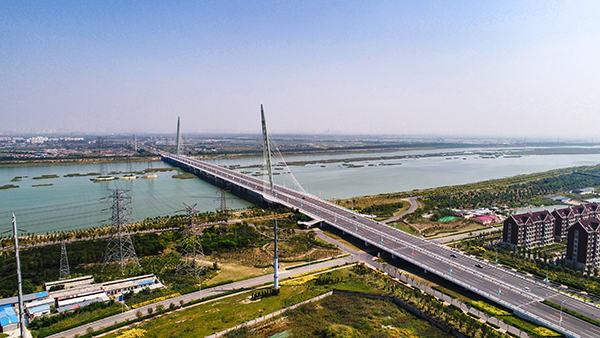
A photo of Jinghai district
Jinghai district is a subordinate district of Tianjin, situated in the southwest of Tianjin. It is adjacent to Binhai New Area to the east, faces Xiqing district across the Duliu River to the northeast. Jinghai is connected to Bazhou city to the northwest, and borders Wen'an county to the west. It is adjacent to Dacheng county to the southwest, connected to Huanghua city to the southeast, and borders with Qing county to the south. The total area is 1,475.68 square kilometers. As of December 2023, Jinghai had a resident population of 776,400 and a registered population of 650,900.
Subdistricts
As of June 2023, Jinghai has 2 streets (Chaoyang Street and Huakang Street), 16 towns (Jinghai, Daqiuzhuang, Chenguantun, Dafengdui, Liangtou, Xizhaizhuang, Ziya, Caigongzhuang, Shuangtang, Wangkou, Yanzhuang, Zhongwng, Tanguantun, Duliu, Tuanbo, and Taitou) and 2 townships (Yang Cheng Zhuang and Liang Wang Zhuang). The government of Jinghai District is located at No. 99 Yingbin Avenue, Jinghai Town.
Geography
Jinghai has a temperate, monsoon climate, and distinct seasons. The landform belongs to the alluvial plain area in the south-central part of Tianjin. Jinghai is situated at the lower reaches of the Haihe River basin, has numerous river channels and is known as the "lower reaches of nine rivers". The South Canal, Ziya River, Daqing River, Heilonggang River, Ma Changjian River and Duliujian River run through the area. The Tuanbo Lake Reservoir is one of two "North-South Ecology" natural reserves in Tianjin, with a water capacity of 180 million cubic meters and a geothermal storage capacity of 8.4 billion cubic meters.
Natural Resources
Mineral Resources
The mineral resources discovered in Jinghai mainly include coal, coal gas, petroleum, natural gas, and underground hot water. Coal-bearing strata of the Carboniferous and Permian systems are widely distributed in the area, with abundant potential reserves. In the southeastern part of the area, including Zhongwang, Dazhuangzi, Dahaozhuang and Caigongzhuang townships, there are thick layers of Tertiary oil and gas shale formations, which are currently exploration and development areas of the Dagang Oilfield.
Land Resources
In 2019, the total land area of Jinghai was 148,660.22 hectares, including 56,239.5 hectares of arable land, 5,012.73 hectares of orchards, 21,483.74 hectares of forest land, 1,643.46 hectares of grassland, 351.5 hectares of wetland, 26,878.04 hectares of residential and independent industrial and mining land, 5,357.42 hectares of land for transportation, and 29,515.83 hectares of water areas and land for water conservancy facilities.
Water Resources
The total surface water resources in Jinghai averages 22.58 billion cubic meters annually, accounting for one-fifteenth of the total amount in the city. Among them, the self-produced water volume is 177.43 million cubic meters and the foreign water volume is 48.37 million cubic meters. In 2008, the per capita water resources occupancy was 378 cubic meters, making it a severely water-deficient area. The exploitable amount of groundwater in Jinghai is 82.14 million cubic meters, including 36.31 million cubic meters of deep water and 45.83 million cubic meters of shallow water.
Social Services
Social security
In 2023, the number of urban enterprise employees who paid into the pension insurance was 142,600, and the number of government and public institution employees who paid into it was 18,000. The number of urban and rural residents who paid into the pension insurance was 158,100, an increase of 2,100 people. The number of urban and rural residents who paid into basic medical insurance was 448,400. The number of people who paid into unemployment insurance was 128,500, an increase of 7,400 people, and the number of people who paid into work-related injury insurance was 132,100, an increase of 6,700 people.
Medical and health care
As of the end of 2023, there were a total of 216 medical and health care institutions in Jinghai district. At the end of the year, there were 3 district-level hospitals, 19 township health centers, and 15 private hospitals. There were 3,708 health technicians, including 1,753 licensed physicians and licensed assistant physicians, and 1,244 registered nurses. At the end of the year, there were 2,031 beds in medical and health care institutions. There were 353 village health care institutions, 561 village doctors, and 201 licensed physicians and assistant physicians.
Culture
In 2023, Jinghai held 9 large-scale artistic performances, and had 1 public libraries (including children's libraries), 384 rural libraries, and a collection of 1.30 million books (including electronic books). There was 1 cultural center, 20 cultural stations in townships (streets), and 1 museum across all townships (streets). There was also 1 calligraphy and painting academy. There was 1 radio and television station, and the actual number of digital TV users was 130,200 households.
Science and technology
In 2023, Jinghai implemented 31 national, municipal, and county-level science and technology projects. The number of patent authorizations was 2,864, an increase of 38.2%, including 239 invention patents. At the end of the year, there were 4 municipal key laboratories, and 5 municipal engineering technology centers. There were 84 newly added national high-tech enterprises, and there were 562 national high-tech enterprises. There were also 20 newly added gazelle enterprises and 149 newly added eagle enterprises.
Education
By the end of 2023, Jinghai district had 3 higher education institutions, 3 secondary vocational schools, 50 regular secondary schools, and 95 primary schools. Higher education institutions enrolled 11,230 students, with a total enrollment of 41,384 and 9,379 graduates. Secondary vocational schools enrolled 1,260 students, with a total enrollment of 3,006 and 805 graduates. Primary schools enrolled 9,815 students, with a total enrollment of 29,702 and 10,105 graduates. Preschool education had 18,743 children enrolled, including 18,665 in kindergartens and 78 in affiliated preschool classes.





